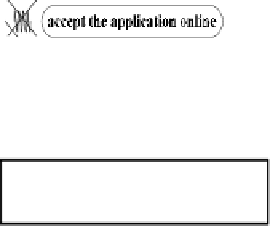Information Technology Reference
In-Depth Information
Fig. 13.
Example of a complex model
Fig. 14.
Translation strategy of complex models, where control nodes link ConstraintContainers
(3):
Start
→
EF
(make an interview per phone)
EF
(make an interview per Internet)
3. We translate the partial quality constraint models which contain ConstraintContain-
ers, which in turn include partial quality constraint models already translated into
CTL-formulas. For example, since (3) and (4) in Fig. 14 are already translated, we
translate (5) depending on the EPPSL patterns in Fig. 9:
(5):
(Start
(4):
Start
→
→
EF
(make an interview per phone))
∨
(Start
→
EF
(make an interview
per Internet))
Then we translate (6) since (2) and (5) are already translated, depending on the
EPPSL patterns in Fig. 9:
(6):
(Start
→¬
EF
(accept the application online))
∧
((Start
→
EF
(make an inter-
EF
(make an interview per Internet)))
4. We always reach a state, where we have two ConstraintContainers, including two
translated partial quality constraint models, and a connector, which connects the
first to the second one. We translate this state depending on the EPPSL patterns
for simple models [21] by stating that the CTL-formula representing the first Con-
straintContainer implies the CTL-formula representing the second one. In Fig. 14,
we reach a state where (1) implies (6). We translate it depending on the EPPSL
patterns in Fig. 9:
view per phone))
∨
(Start
→



















































































